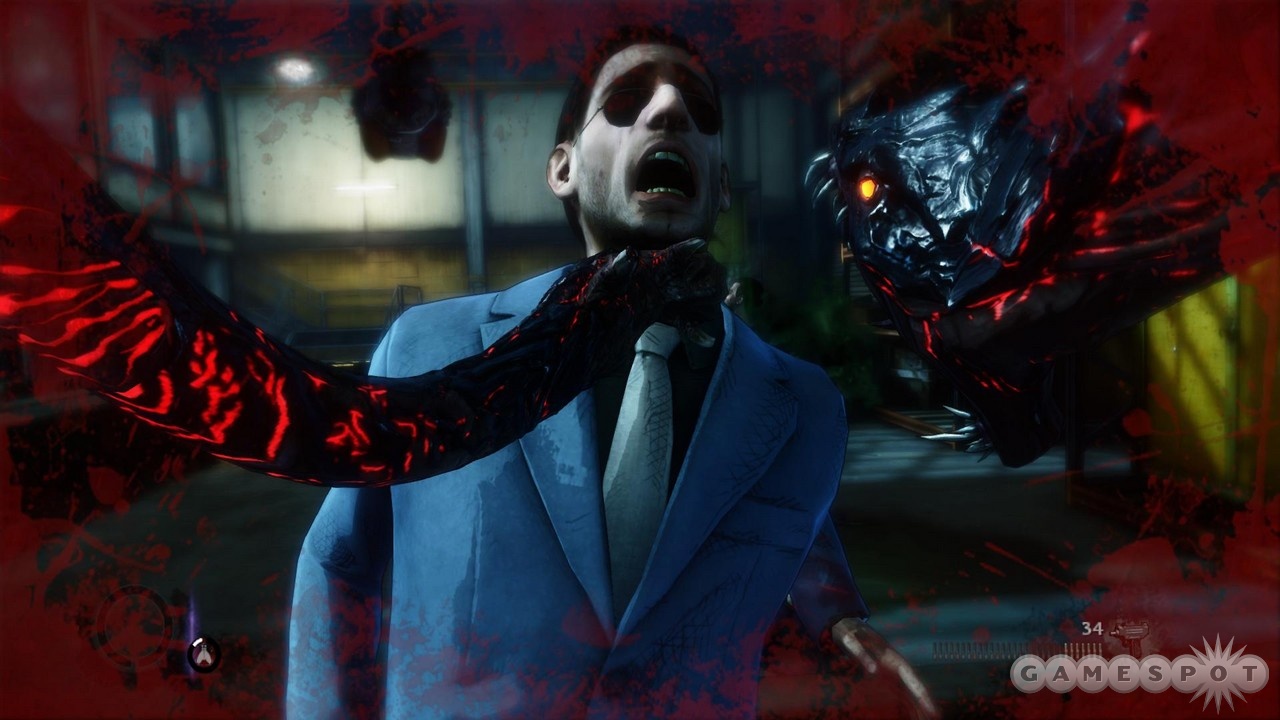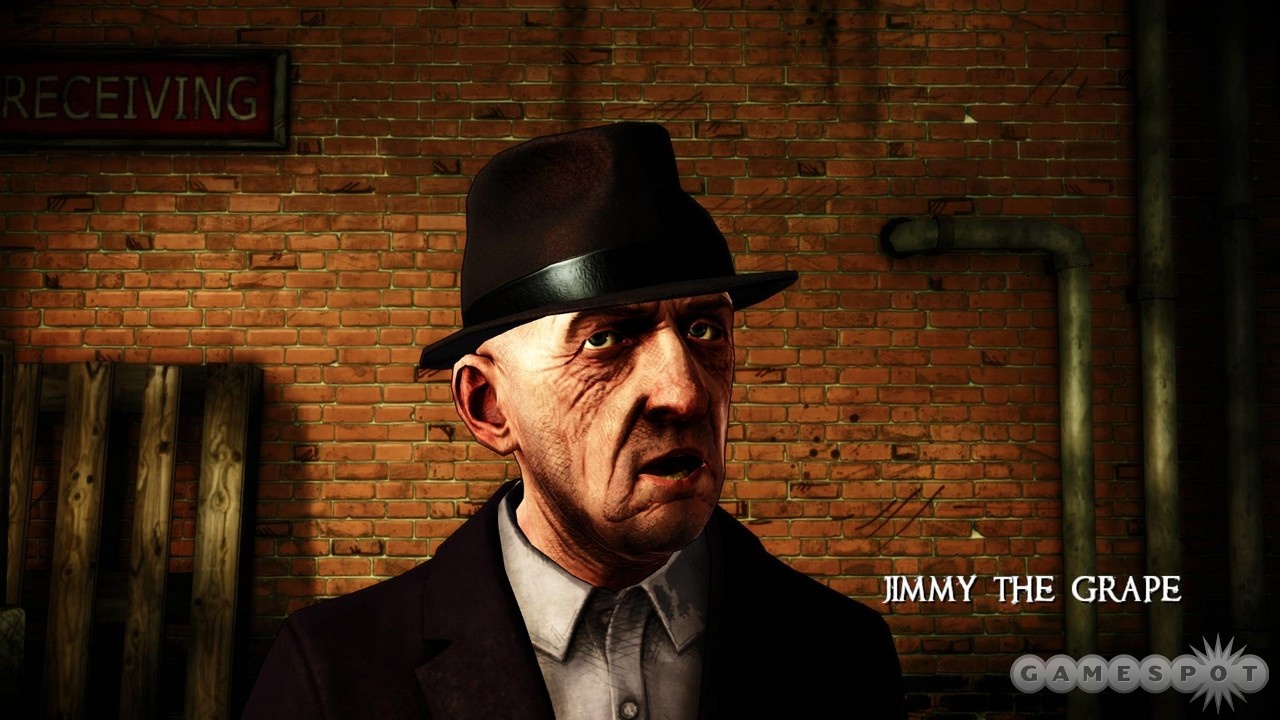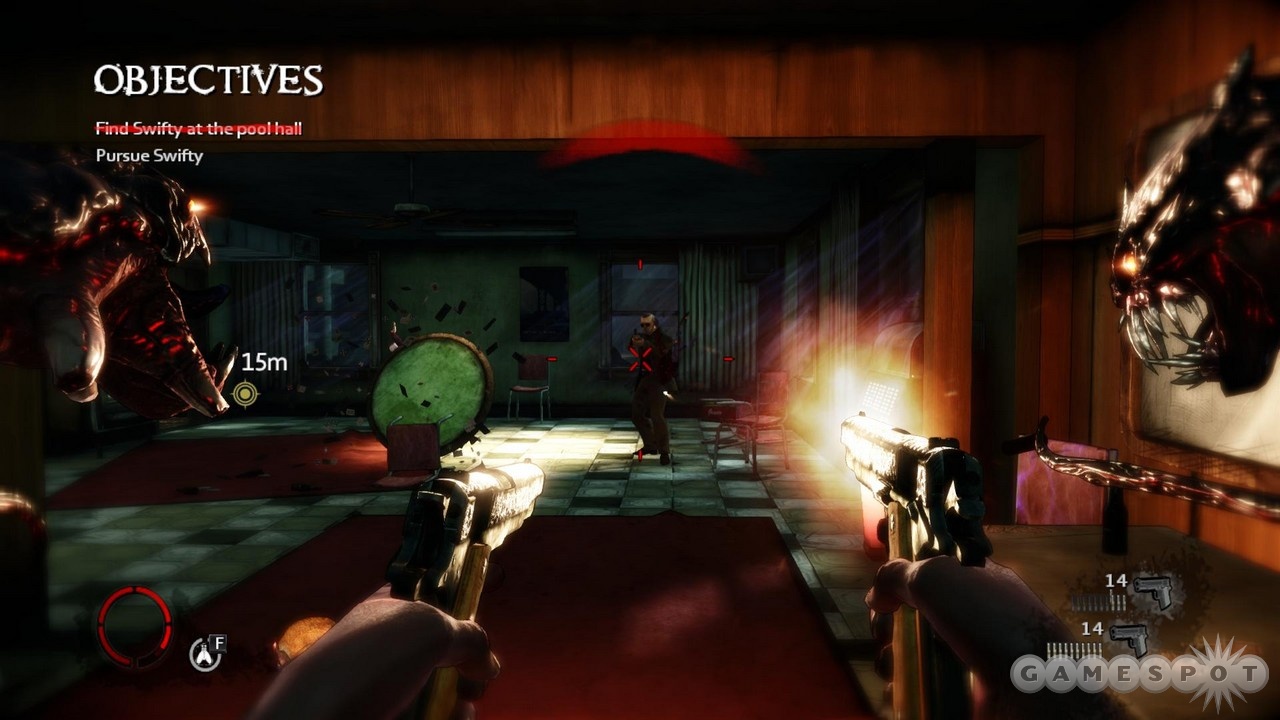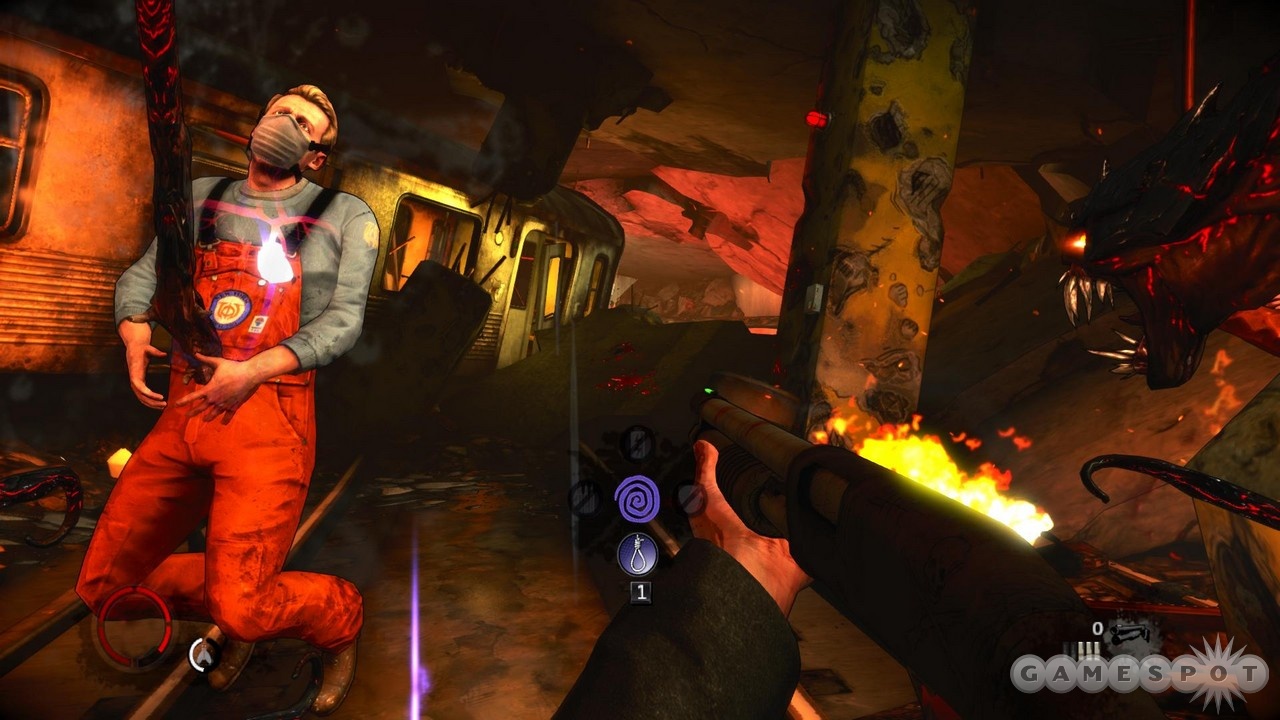The Darkness II is a shooter.
OK, so that seems a pretty odd statement to make: Of course The Darkness II is a shooter! But in this sequel's case, it's an important point to consider. The Darkness (the original game on consoles) had the feel of an adventure. Sure, you shot guns, but the action, the story, and the peripheral details merged to make a single, creative whole that didn't really resemble other first-person shooters. The Darkness II is a lot of fun, but it doesn't have that spark of uniqueness. Levels are remarkably linear, and the game is remarkably short. Skilled marksmen should finish the campaign in less than five hours.
So The Darkness II isn't special, but it has one particular element that keeps it exciting: the two creepy demonic arms that sprout from your body, each with its own gnashing mouth, and each with an insatiable appetite for human hearts. The right arm is for smashing; you can whip it around with abandon, using the right stick to slash vertically or horizontally, bashing enemies, street lamps, and electrical wires. The left arm is for grabbing; you can grab car doors to use as shields and fling them at mobsters like murderous Frisbees. You can throw metal poles at your foes and impale them as if preparing a human-sized shish kebob. You can also reel in a staggered enemy, grab each leg, and tear him in half like a wishbone. A wishbone that screams.
If that sounds gross, well, it is, in a wonderful way. Take the anaconda move. With this particular left-arm maneuver, you roll your foe up like a pig in a blanket and thrust the demonic head through his chest. The demon then growls in satisfaction before unrolling and allowing the limp body to drop to the ground. As you move toward The Darkness II's conclusion, you see this move and other similarly disgusting ones rather often, and they remain shocking for a little while. The sound effects are fantastically squishy; you can practically hear the cartilage tear and the vital organs rupture. To replenish health, you hold a button and your arms feed on nearby human hearts, snatching them up with a thwack and noisily chomping on them.

The game's upgrade system might have you unlocking new animations, but even then, the gross-out factor can wear thin. This is in part because you can string together the same basic moves in succession, over and over, without feeling challenged, particularly on the PC. You're invulnerable during these kills, which is just as well because it would be pretty frustrating to get shot to death while waiting for your demon arms to finish some horrific dismemberment. In time, The Darkness II tries to amp up the challenge, throwing enemies at you with tough shields and introducing combatants that shine spotlights on you. All that light causes your demon arms to regress while filling your screen with so much blinding whiteness that you can barely see what's going on. But generally speaking, you can charge forward, shooting, flinging, and grabbing without worrying often about dying. As long as you shoot out any errant light sources, you won't feel much pressure on anything but the hardest difficulty.
The Darkness II does its best to provide variety. Depending on how you upgrade as you progress, you might unleash a swarm of insects at your enemies, which makes them vulnerable to a nauseating fatality. Or you might summon a mini black hole, which sucks in any nearby enemies into its swirling vortex. There's also your darkling, a miniature gremlin that calls you "monkey" and skitters around, leaping on bad guys and urinating on helpless corpses. Well, with the right upgrade, you can pick up your darkling and throw it on anyone that gives you trouble. Combining these moves with standard pistols and rifles can be absolutely riotous, with arms flying everywhere and enemies screaming in agony as you tear them in half.

Nevertheless, the demon arm mechanic is expected to bear most of the burden, and central aspects of the game's action are mundane. The shooting is better than that of the first game, but then again, the original was paced and built very differently. The Darkness II typically funnels you down paths like any random shooter. Levels occasionally open up a bit, but this sequel is as linear as games come, sending out unintelligent enemies in predictable patterns. Heck, even the levels themselves are right out of the book of shooter and horror game cliches: a subway, a warehouse, a creepy carnival, and the like. If The Darkness was an ambient action adventure, then The Darkness II is an arcade shooter. If you have any doubt about that, consider this: When you kill enemies, a pop-up appears, announcing the name of the move, along with the amount of dark essence (that is, experience) you earned. It's done sort of like Bulletstorm's skill shot system.
You should turn off those notifications at the first opportunity if you want to get the most out of The Darkness II. (Be sure to also turn off the annoying tutorial reminders that frequently appear, reminding you how to play the game even when you've almost finished it.) That's because there's an effective story here worth paying attention to, but the pop-ups only serve to take you out of the experience and remind you that you're just playing a game. Once again, you play as Jackie Estacado, who is now the leader of the Franchetti crime family. The story gets off to an explosive start, with an intense on-rails restaurant shoot-out that ultimately leads to the eye-opening emergence of The Darkness; that is, the hellish presence that grants Jackie his incredible powers.
The differences between The Darkness II and its predecessor extend to the visual design. Whereas the first game's visuals were grim and ominous, the sequel is heavily cel-shaded. There's a vibrant grittiness to the art design. For instance, in an early subway level, cracks crisscross the tiled walls and graffiti is scrawled on the subway cars. These grimy touches contrast with the purple glow of your demonic arms, the vivid orange pants of your enemies, and the crimson puddles of blood these goons gush as you have your way with them. The intense visuals are a nice complement to a game that traffics in intense and sudden shocks, not in pervasive dread.
The story matches the tone of the visuals and the gameplay, putting Jackie in some horrific situations that might have you squirming in your seat. Yet, as squeamish as some of these moments are, they don't feel like cheap ploys meant to make your stomach churn. The story earns the right to shock you because The Darkness II takes time to breathe and develop its characters. A scene in a gloomy cemetery allows you the chance to grieve, which makes the surprising sight that kicks off the ensuing shoot-out all the more harrowing. Between missions, you chat with family members, both the mafia kind of family, as well as the kind related to you. As in the first game, Jackie delivers thoughtful monologues while levels load. Even your little darkling gets to take center stage in an oddly emotional moment near the end of the game. The game's excellent ensemble cast sells each and every line and situation. You believe Jackie's desperation as he navigates the sterile white hallways of a mental institution. You believe in Johnny's hypercaffeinated, unhinged levels of anxiety. When The Darkness whines, groans, and pleads to Jackie, it's like hearing the voice of chaos itself, just barely constrained by its human host.
And then there's Jenny, the girlfriend Jackie watched get murdered in the first game. Yet here she is, her ghostly image constantly urging him forward. On the occasions Jackie catches up to her, they share brief but tender moments that effectively illustrate his dedication. But is she real? And if not, how is it that Jackie sees her and interacts with her? Some of The Darkness II's best moments come when it plays with your expectations and has you wondering: What is real and what is imagined? And ultimately, does it really matter? The story gathers up all the assumptions you made from the beginning and turns them inside out.

The biggest shock you might get from The Darkness II is its incredibly short length. Fortunately, the experience doesn't have to be over once you've finished the story. You can always go back and play a new-game-plus, carrying over all the upgrades you purchased and further progressing through the surprisingly extensive skill tree. But the remaining value comes mainly from Vendetta mode, where you can tackle missions alone or with up to three others online. (However, the Vendetta campaign doesn't greatly lengthen the experience: you can finish it in 90 minutes or less.) Here, you control one of four different characters with different traits and skill trees of their own. You don't eat hearts to regain health in this mode: you destroy them.
The Vendetta campaign's story runs in parallel with the single-player mystery, but the focus isn't on narrative: it's on gunplay. You don't get a pair of demonic tentacles lolling to your sides, but you might have a powerful supernatural weapon that you charge up and then fire at your foes. Or you might have a sword for slicing, dicing, and plunging into the chests of the fallen dead. Or you might even have an arcane staff that raises mobsters into the air and twists them in half--another horrific bit of brutality that might shock you the first few times, even if you just spent hours tearing men apart with demon arms.

In spite of these twists (as it were), the Vendetta missions aren't as satisfying as Jackie's adventure into the unknown. Whereas the single-player campaign plays with pace and player expectations, Vendetta mode is about shooting stuff with friends. This isn't a bad concept for a cooperative mode, of course, but you need to crank up the difficulty level to the highest setting if you wish to be remotely challenged by The Darkness II's blockheaded AI, even in the few boss fights. At least the final boss fight pits you against a ghastly foe--an over-the-top monstrosity in a game with an over-the-top attitude. It's an improvement over the mundane rivals that teleport around in the story campaign's boss encounters.
Faults notwithstanding, The Darkness II's menacing story and macabre action are accentuated by memorable moments worth experiencing. Unlike the original game, the sequel doesn't brood: it shrieks and snarls, the shrill voice of The Darkness echoing in your head as you flail your demonic appendages about as a man literally possessed. When you break the game down, however, you notice that The Darkness II isn't a lot different from other shooters. Levels are linear and predictable, focused on ushering you from one straightforward encounter to another so that you can go crazy with those deranged arms of yours. If you are a fan of the original game, bear this in mind: The Darkness II is a fun, very short FPS without the authentic atmosphere and subtle touches that made its predecessor so intriguing. Still, if you've got a lust for virtual blood, The Darkness II leaks enough of it to satiate you.



